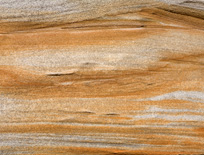The Case of the Vanishing Stone

 Natural stone is a wonderful companion for just about every type of watershape: It lends a timeless, classy look to just about any setting, generating a sense of sturdy permanence as well as close associations with Mother Nature.
Natural stone is a wonderful companion for just about every type of watershape: It lends a timeless, classy look to just about any setting, generating a sense of sturdy permanence as well as close associations with Mother Nature.
As watershapers, we also know that natural stone can be extremely expensive and often represents a significant investment on the part of the client. This puts a premium on proper stone selection relative to the specific application — and that’s where some people run into trouble.
Here’s a classic case illustrating why it pays to know your stone.
Scenario: The homeowner contracted with a swimming pool company, asking them to build a backyard pool that included a large waterfall made with natural stone. The homeowner went with the contractor to a local rock yard to pick out the stone, ultimately settling on a local sedimentary type found in the hills in and around the area in Southern California where the homeowner lived.
From a purely aesthetic standpoint, they made the right choice in selecting an indigenous stone that would look natural in the landscape. Unfortunately, however, this was not a stone that had been immersed for centuries and was probably the worst possible choice for this particular application.
Once installation was complete, the homeowner couldn’t help noticing that every time the waterfall ran, chunks of rock material would slough off and fall into the pool. And when the kids went climbing, their hands would break pieces off, and those pieces rapidly dissolved when they came in contact with the water — great sport for curious children, who repeated the “experiment” over and over again.
Of course, the homeowner wanted the contractor to correct the situation. In response, the contractor claimed ignorance, saying he wasn’t a geologist, and that in any event, the client had picked the stone and was responsible for the failure. This impasse led to a lawsuit (in which I was called in as an expert witness by the homeowner), and not surprisingly, the contractor came out on the losing end.
The Fix: In this case, the remedy involved my company coming aboard and completing a total reconstruction of the waterfall using material that could withstand direct exposure to water.
Lesson Learned: The lesson here is not so much that you should accept responsibility for such issues (which goes without saying); rather, it is that, as a watershaper, you need to know the basic characteristics of the materials with which you’re working. While nobody expects a watershaper to be a geologist, all clients have a reasonable expectation that their contractor is informed about the materials that will be used and knows how they will perform in a given application.
At my company we have a simple rule: If the stone is found in water in nature (a river rock, say, or an exposed granite), we know it’s almost sure to be suitable for an aquatic application. Beyond that, if there’s any question at all, we will ask the supplier and/or find other ways to gain the information we need to make the right call. And if there’s any doubt at that point, we recommend selection of a stone we can trust.
I know there are some who will say any stone can be used: All you need to do is seal it properly and it will be fine. My own experience has taught me otherwise. You cannot permanently alter the nature of the stone with one round of chemical sealing, and in any situation in which the sealer must be periodically reapplied, it’s a simple fact that few homeowners will keep up with the routine in perpetuity.
The real solution is to pick a stone you know for certain will withstand the corrosive effects of water. If you want to add a layer of protection with a sealer, that’s fine — but it definitely has been my view that starting with the right material is always best.
Bottom line: Know your materials and try to work with their natural characteristics rather than against them.
Scott Cohen is president and supervising designer of The Green Scene, an outdoor design and construction firm based in Northridge, Calif. He provides consultation for clients nationwide and gives seminars on designing landscapes, swimming pools and outdoor kitchens. For more information, go to www.greenscenelandscape.com.









